Start running now with fun, challenging workouts you can do in a half hour or less.
Jenny Chang for BuzzFeed
These running workouts were created especially for BuzzFeed Life by two RRCA-certified professional coaches, Janet Hamilton and John Honerkamp, who have 45 years of coaching experience between them. These dynamic workouts are fun and fast-paced — and they won’t feel tedious.
Plus, they can each be done in about 30 minutes (including a warm up and cool down) and can be adjusted to be made easier or more challenging. And you can do them all outside if you want, or on a treadmill.
Follow these workouts and you’ll go from this:

NBC / Via Netflix
To THIS

4 things you need to know before you get started:
1. The running workouts listed below are listed in order from least challenging to most.
2. Brand new runners should build a base of fitness before tackling the harder workouts. Coach Hamilton recommends jumping into the harder workouts as written once you’re “consistently running three to five times per week for 30 minutes at a time and are injury free.” That means that if you’re not a runner at all right now, start with the first few running workouts on this list until you’re doing them consistently multiple days a week. Another thing: Each one of these workouts can be modified so that they’re less intense or shorter, “but listen to your body and don’t beat yourself up,” Hamilton says.
3. You should always warm up before and cool down after. Each workout includes instructions for both.
4. We’re using a scale from 1 to 10 of rate of perceived exertion (RPE), rather than telling you what treadmill setting to use, which would differ from person to person and doesn’t apply to outdoor running. According to our RPE scale, 0 is no exertion, 1 is a light walk, 10 is all-out sprinting as fast as you can go, and 5 is running but at a moderate intensity pace — you can still carry on a conversation easily. This is a much healthier and smarter way to calculate your intensity than dialing up the treadmill.
For each workout, we prescribe an RPE and a length of time that you should keep it up. For example “5 minutes: 5 RPE” would mean that you should run for 5 minutes at a moderate pace that would allow you to comfortably hold a conversation with a running buddy. For RPE 2 or 3 (easy and fairly easy), that can mean a brisk walk or a light jog, depending on your own fitness level and what feels right to you. Typically RPE 2 or 3 applies to rest periods or cool-downs, so whatever you need at that moment is good — use your judgment and pay attention to your own body.
The scale is based on the Borg Scale of Perceived Exertion and simplified by Coach Honerkamp, who says that it’s not an exact science and will get easier to use as you continue running.
Here’s what all the RPE numbers mean, for reference:
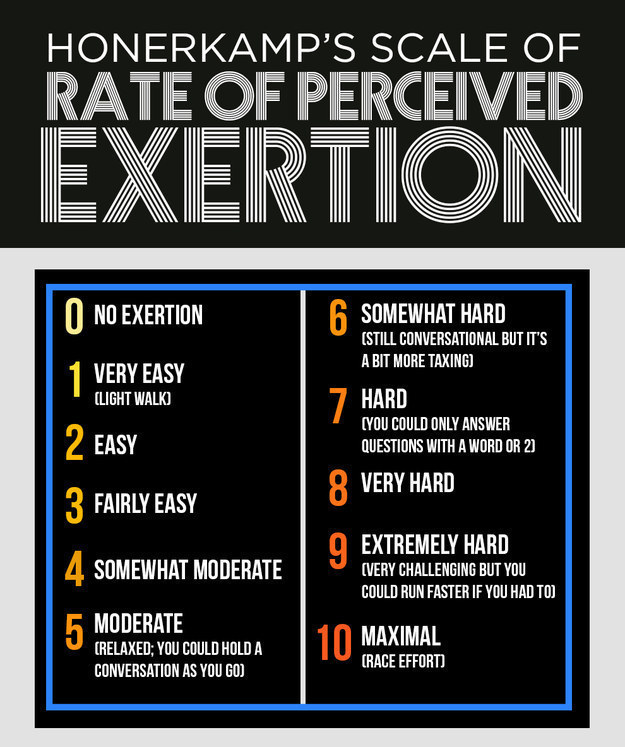
Jenny Chang for BuzzFeed
Got all that? Great. Let’s do this thing.
Get Started Running
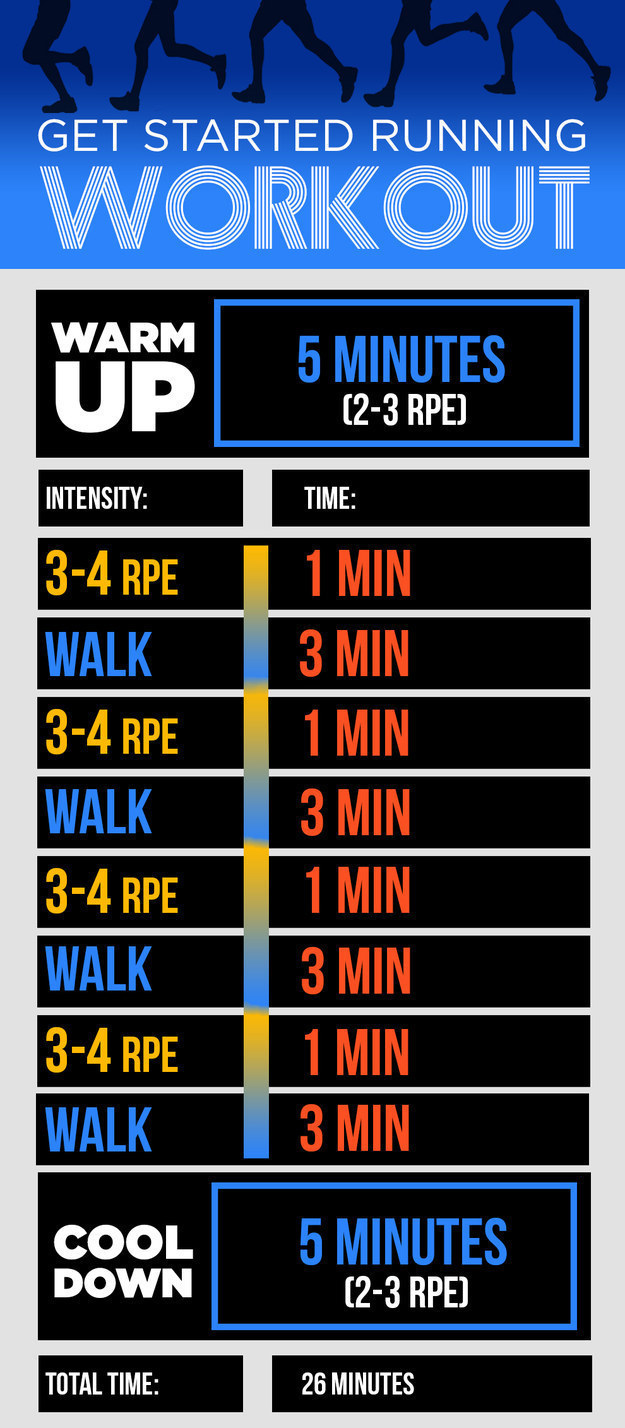
Jenny Chang for BuzzFeed
New to running? Start here. This workout is mostly brisk walking with some faster running sprinkled in. And yes: It definitely still counts as a run even if you walk from time to time. You have to start somewhere!
Make it harder: Transition from a 1-to-3 ratio of walking to running, to 2-to-2… then 3-to-1.
Make it easier: Keep at a 1-to-3 ratio throughout (or 1-to-4 if you have to).
Fartlek “Speedplay”
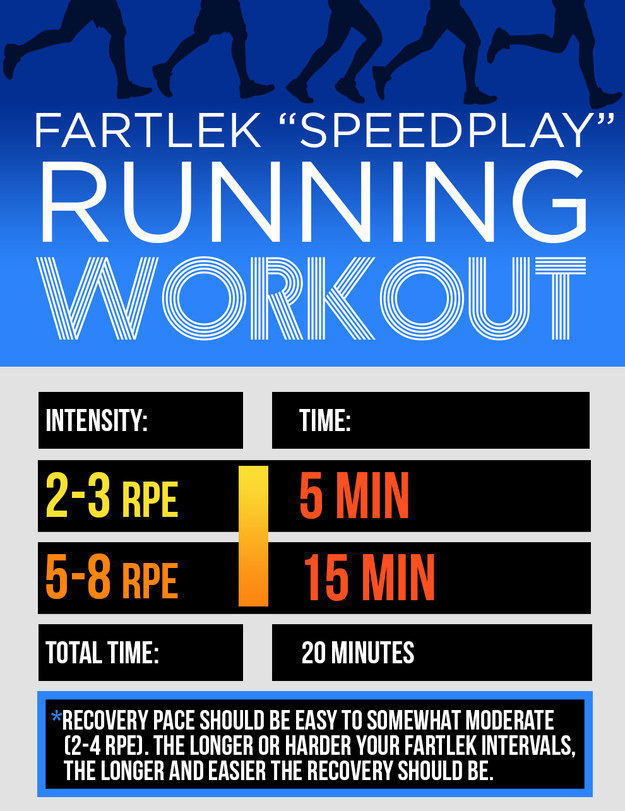
This workout is totally unstructured — you decide when to speed up, and it can be random (e.g. sprint from the next tree to the next traffic light) or structured (e.g. sprint every 2 minutes for 15 seconds) if you feel like it.
Make it harder: Increase the total length of each interval where you’re running hard (pick a destination that’s farther away, for instance, or choose to sprint for a longer period of time). You can also increase the total workout time.
Make it easier: Run hard to a landmark (a tree, a pole, whatever) whenever you feel up to it, but don’t pressure yourself to do the hard run intervals with any consistency. Have fun.
Short Intervals
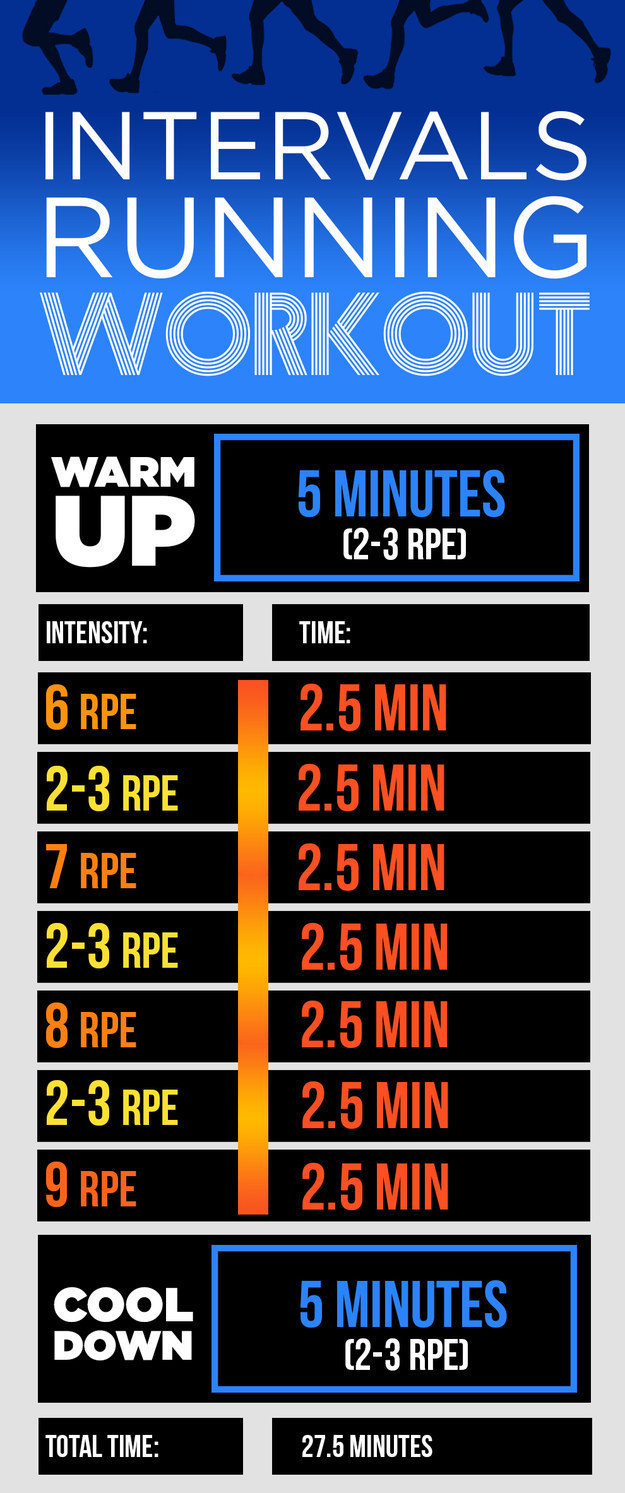
Jenny Chang for BuzzFeed
Interval workouts are the bread and butter of any runner’s training program. You can easily adjust them to match your fitness level by making the intervals longer or shorter as necessary.
Make it harder: Right now this workout has you doing 4 × 2.5-minute sprints, with 2.5 minutes of rest between them. Speed up your sprints (and rest periods), and do 8 × 1-minute sprints with only 30 seconds rest between them.
Make it easier: Do only 4 × 1-minute sprints (instead of 4 × 2.5-minute sprints), with 2 minutes rest in between. This will shorten the total duration of the workout, and also shorten how long you’re sprinting.
Time Ladder

Jenny Chang for BuzzFeed
These versatile workouts are a great way to mix things up and keep your workouts from feeling static and boring.
Make it harder: Add additional intervals. As many as you want. Start with an extra three sprint-rest intervals and see how that feels… add or subtract intervals based on what your body is telling you.
Make it easier: Simplify the whole thing — that means throughout the whole workout, alternate between 2 minutes hard (6 PRE) and 1 minute easy (2 – 3 RPE).
Intro to 5-K

Jenny Chang for BuzzFeed
Gearing up to race (or just finish) 3.2 miles? If you include this workout as part of a rotation of regular weekly runs, it can help you prepare for the big day.
Make it harder: Increase the length of your hard intervals to 2.5 or even 3 minutes, if you can handle it.
Make it easier: Shorten your intervals. Make the hard ones 1 minute long, with 30 seconds easier pace in between.
Hill Ladder Workout

Jenny Chang for BuzzFeed
Running coach John Honerkamp swears by hills as a way to help runners work on getting faster without the injury risk that comes from sprinting on flat surfaces (which can over-tax your hamstrings and calves).
If you’re on a treadmill, when it says “rest” you should literally stand on the outsides of the treadmill and not move at all — this is way easier than going back and forth with the incline and speed buttons between each hill.
Make it harder: If you’re outside, shorten the rest period. If you’re on a treadmill, increase the length of your hill sprints.
Make it easier: Ease up on the RPE (aim for 5 – 6). Walk on your rest.
Tempo Run
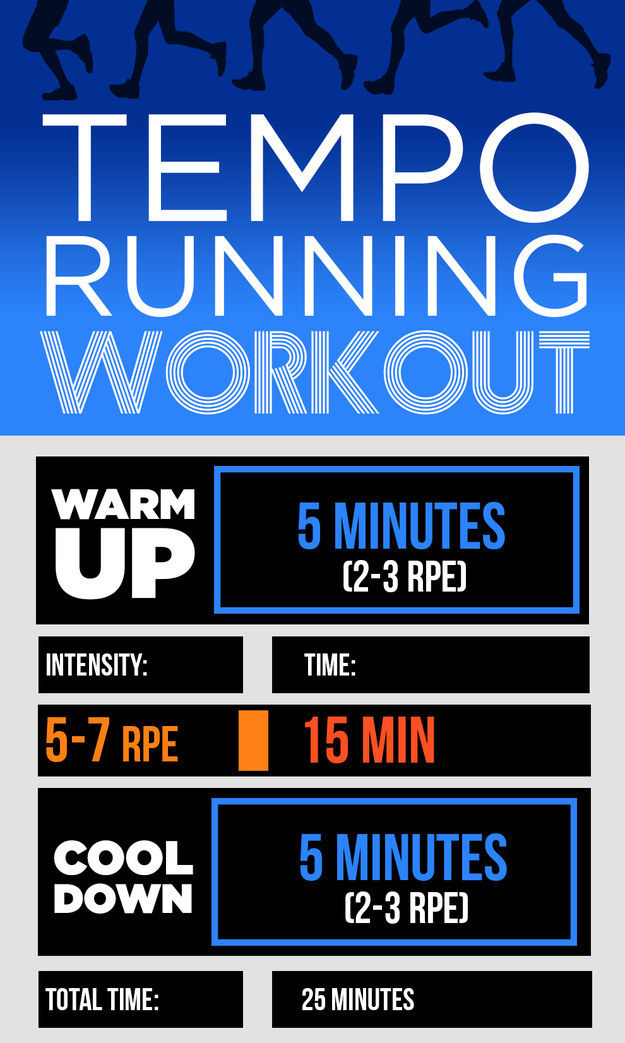
Jenny Chang for BuzzFeed
These staple running workouts challenge you to maintain a “comfortably hard” pace for the main portion of your run. Tempo workouts can help you get used to a sustained aerobic challenge.
Make it harder: Increase your RPE or the length of the tempo portion of the run.
Make it easier: Shorten the tempo and dial down your effort so you feel comfortable.
Long Intervals
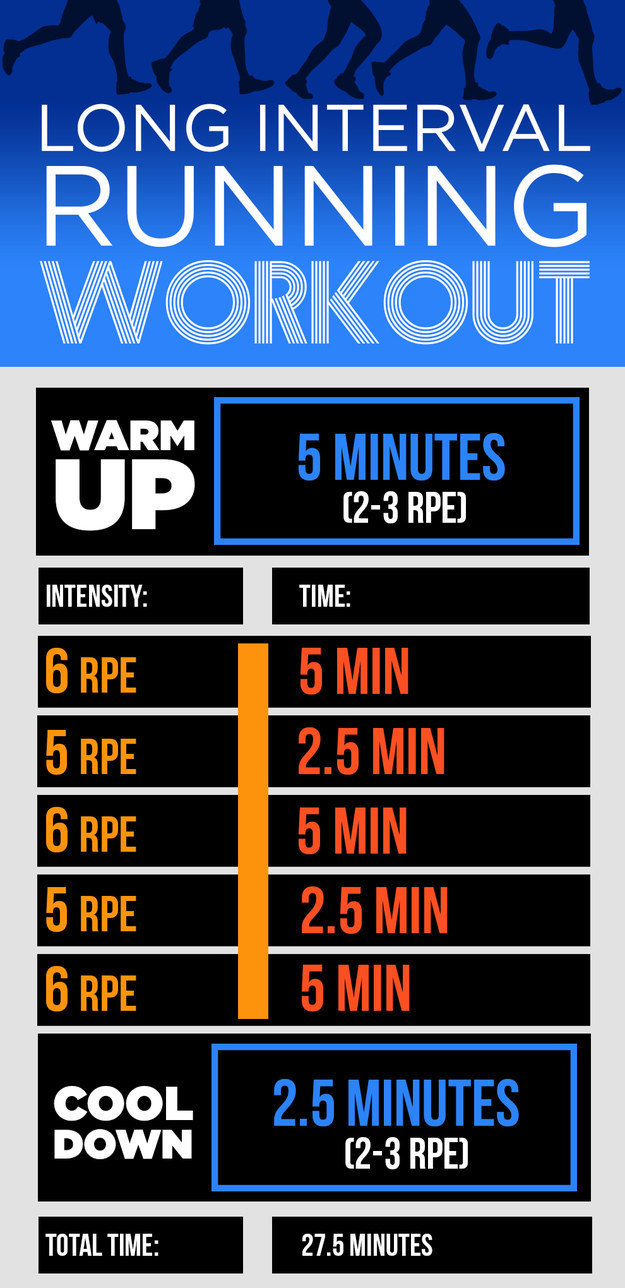
Jenny Chang for BuzzFeed
If you want to run a 10K, this workout will get you used to running at race pace for longer intervals and help you focus on how it feels to run at a target pace for a sustained period of time.
Make it harder: Add additional hard running intervals.
Make it easier: Increase your rest period, or take extra rest halfway through.
Surges
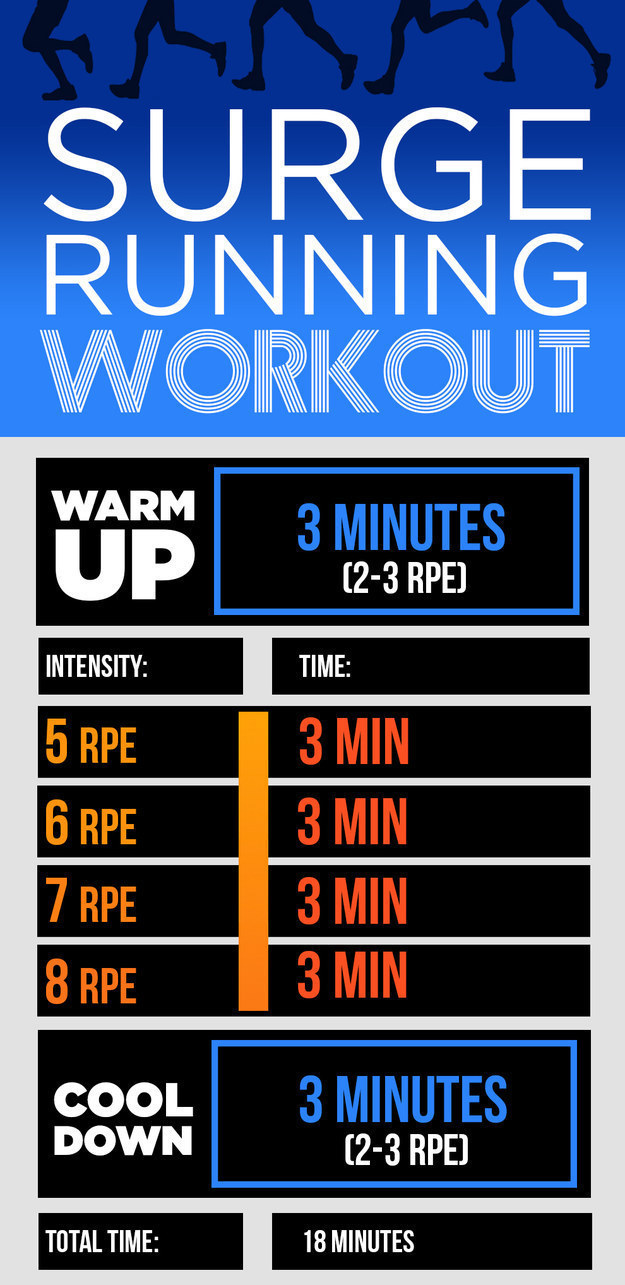
Jenny Chang for BuzzFeed
This workout is best for slightly more experienced runners with a decent cardiovascular fitness base. It challenges your speed and endurance.
Make it harder: Increase your RPE sooner — every 2 minutes, instead of every 3 minutes.
Make it easier: Keep your surges to 1 minute or less, and keep your RPE no higher than 5 – 7.


















